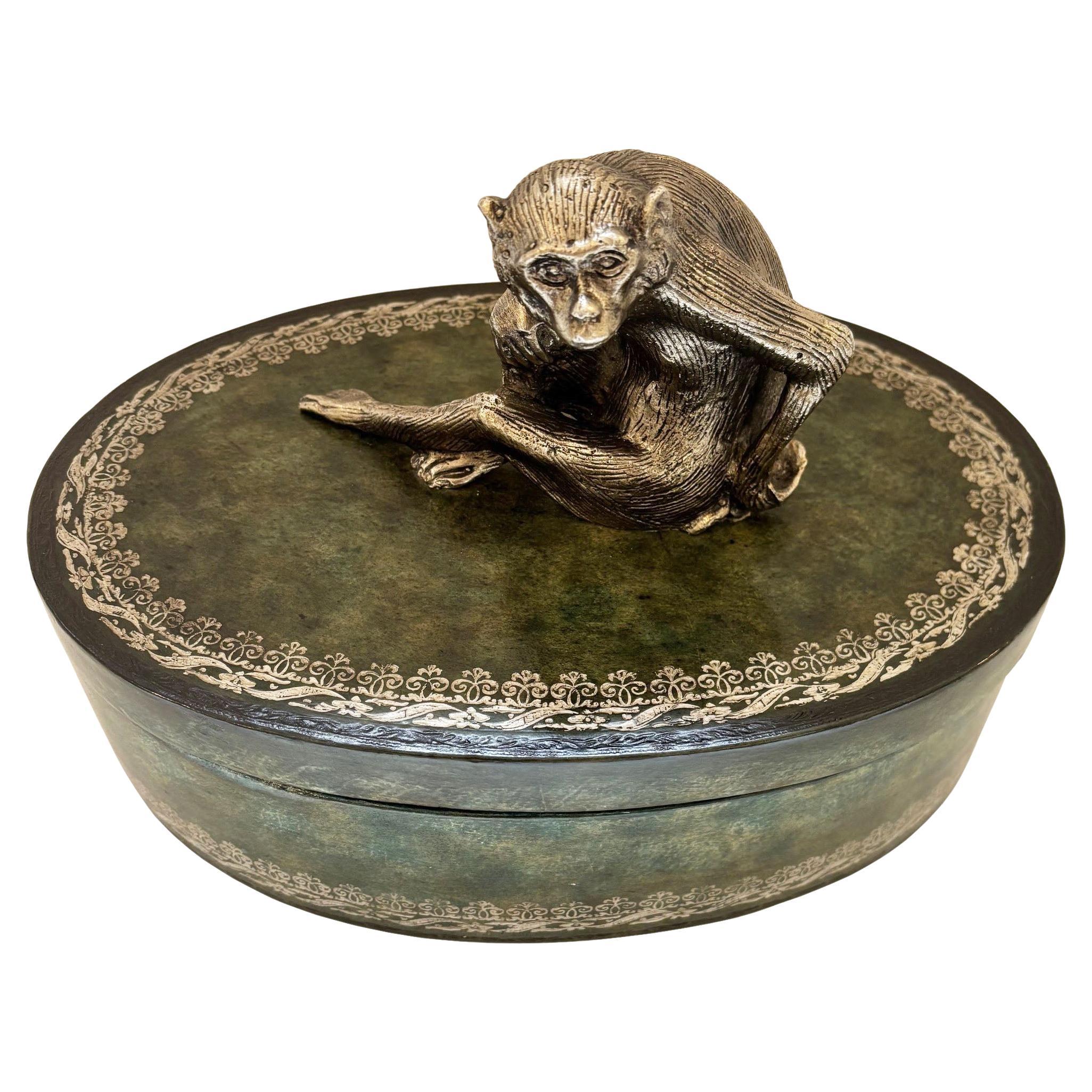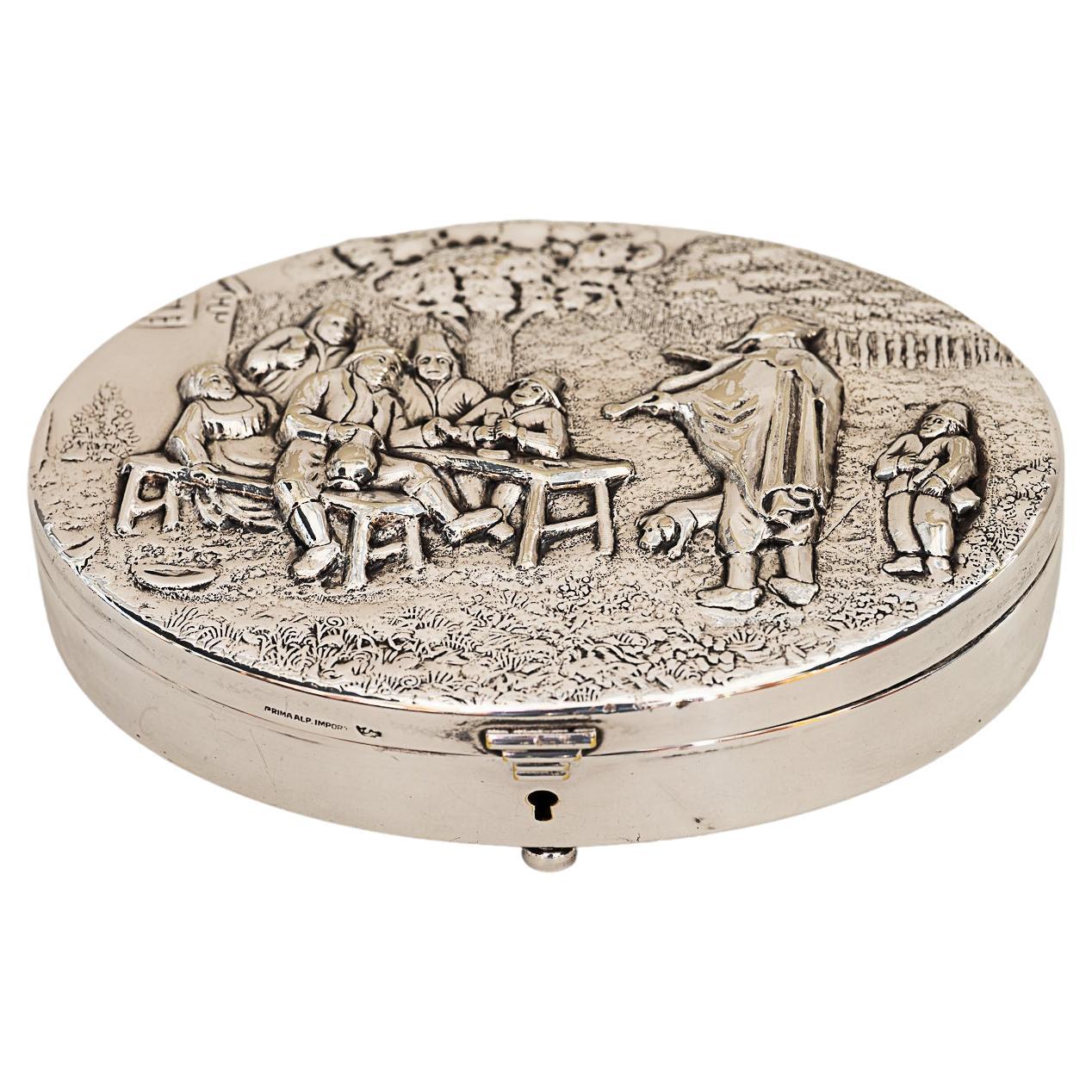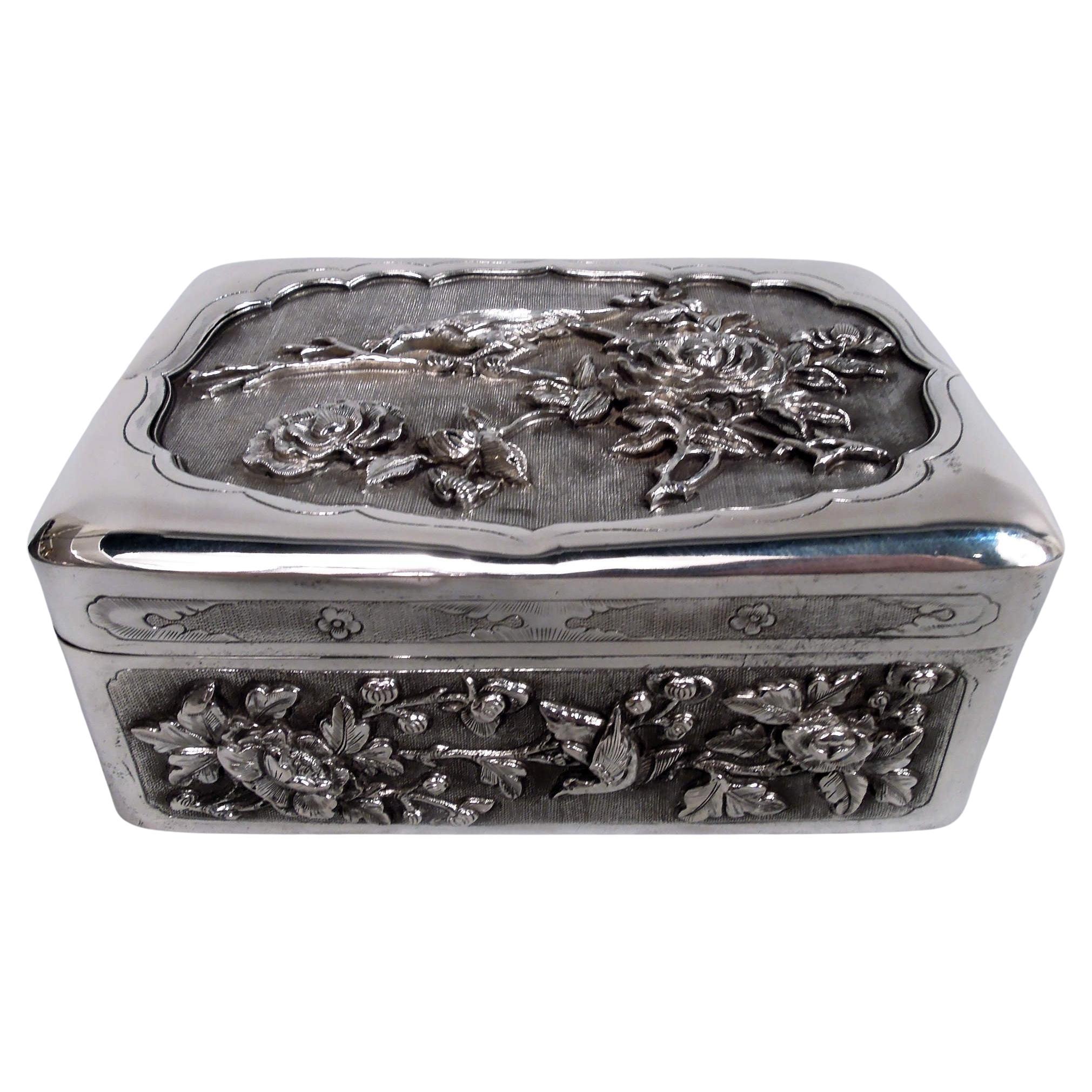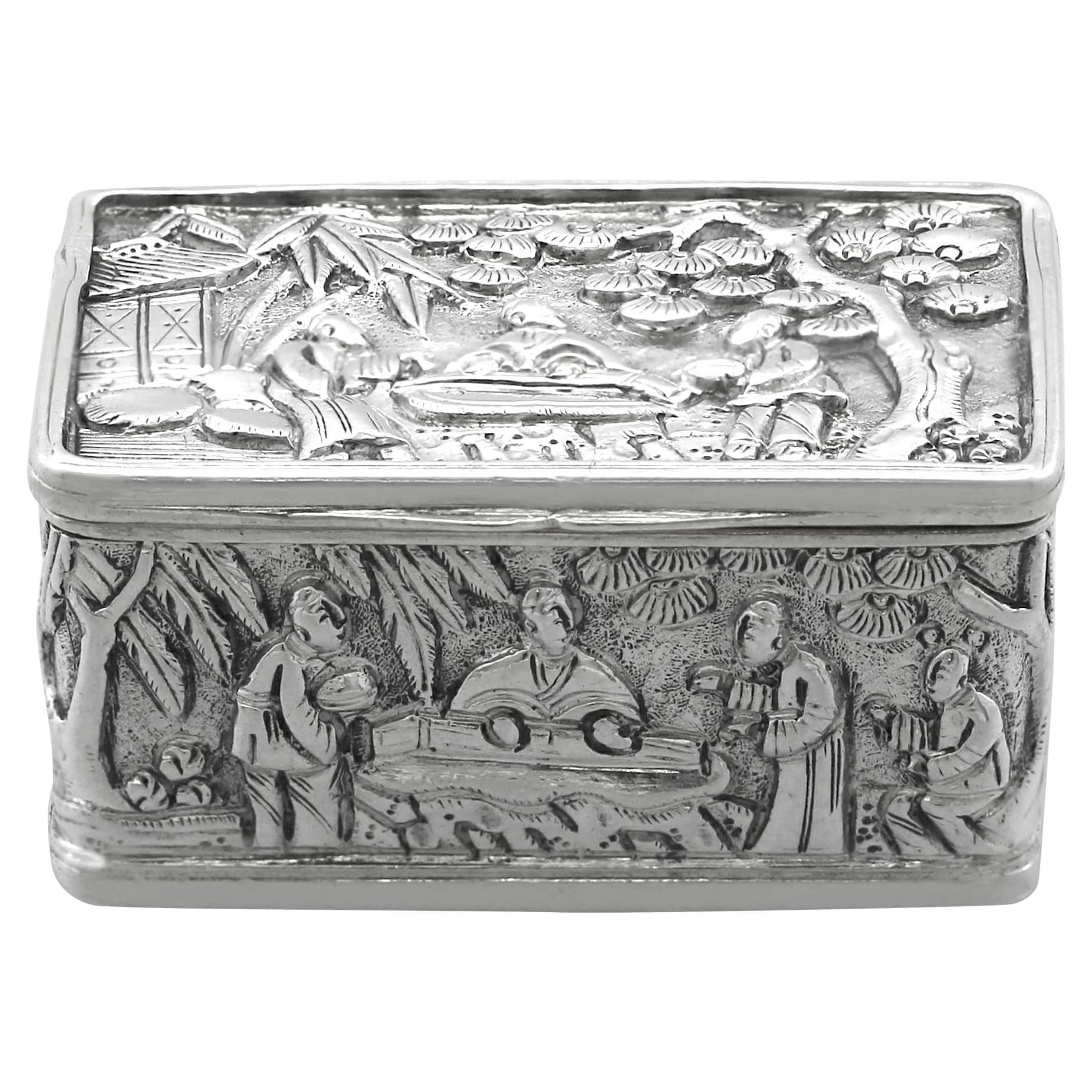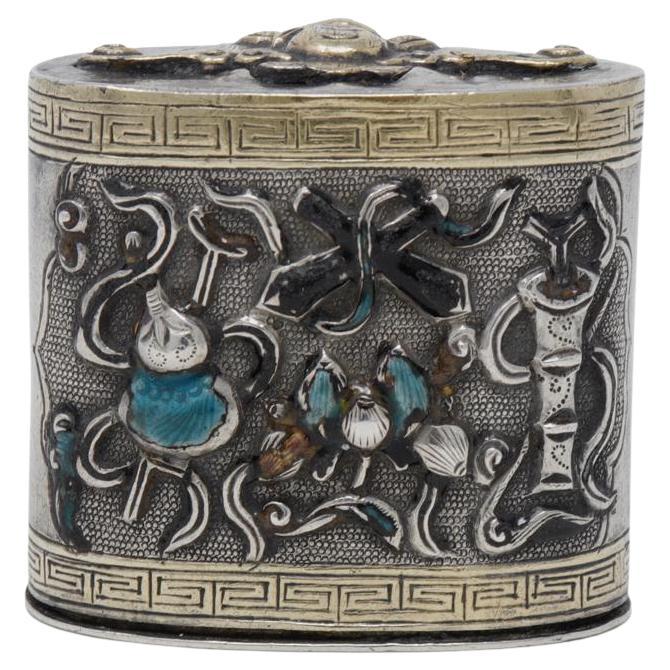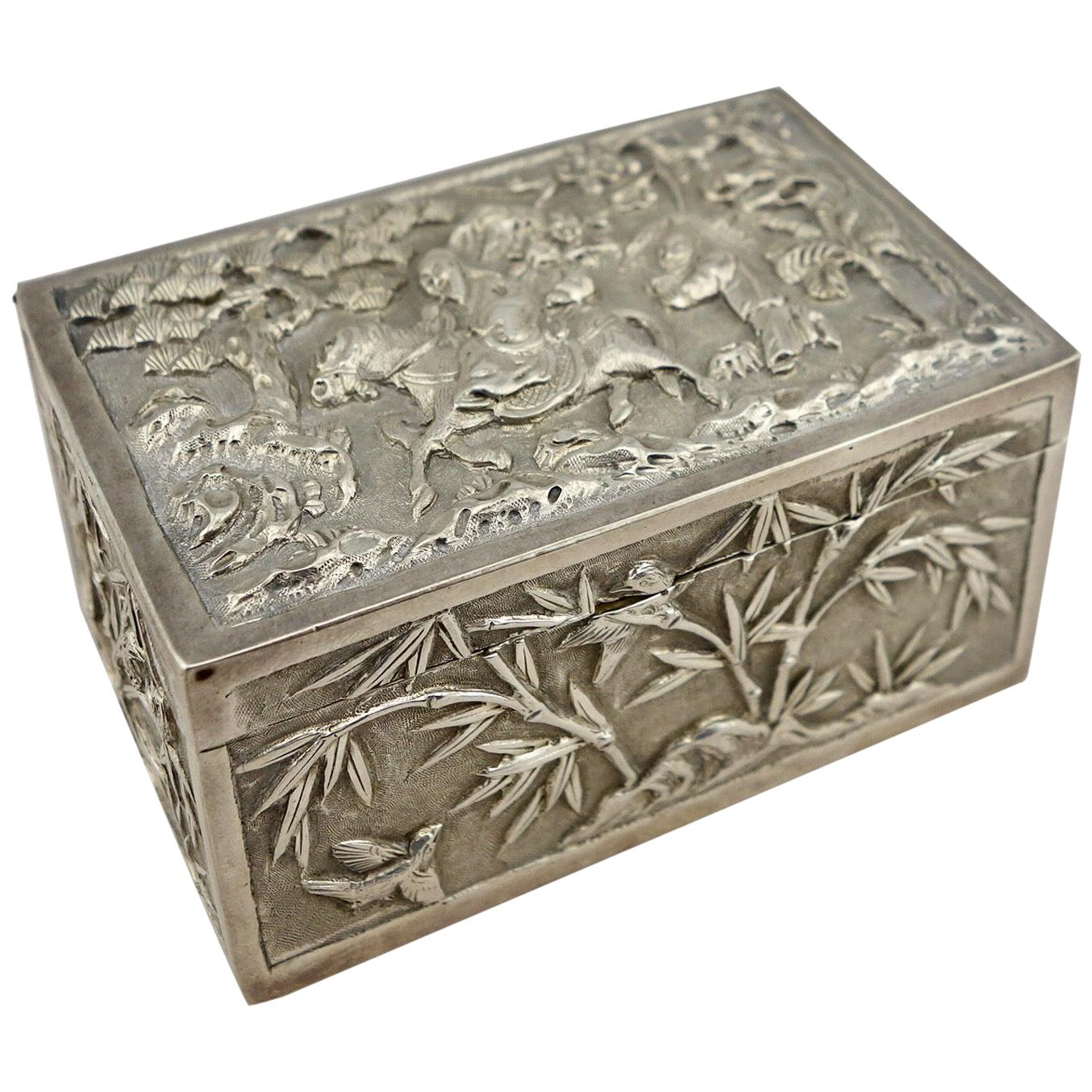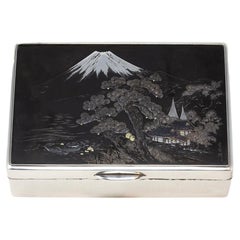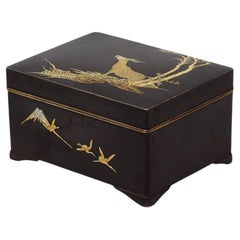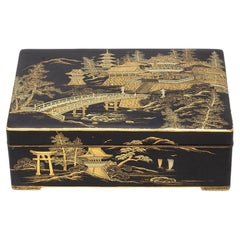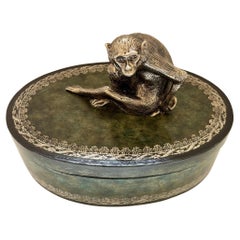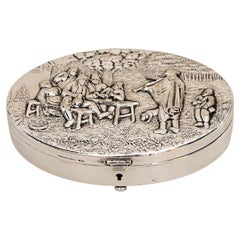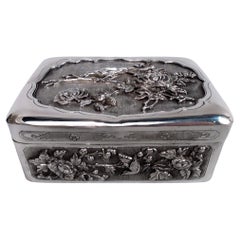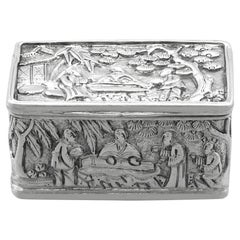Items Similar to Antique Japanese Meiji Silver & Enamel Box Three Wise Monkeys Komyo, Uyeda
Want more images or videos?
Request additional images or videos from the seller
1 of 18
Antique Japanese Meiji Silver & Enamel Box Three Wise Monkeys Komyo, Uyeda
$5,149.02
£3,750
€4,381.23
CA$7,150
A$7,802.31
CHF 4,092.45
MX$94,761.69
NOK 51,116.88
SEK 48,308.01
DKK 32,699.83
About the Item
Japanese Silver & Enamel
From our Japanese collection, we are delighted to offer this Japanese Silver Box by Komyo 光明. The Silver box of rectangular form with rounded corners features the Three Wise Monkeys to the front, see no evil, hear no evil and speak no evil. The monkeys cast beautifully with naturalistic features wearing humorous enamelled haori (羽織). The box is covered with katakiribori (engraving with an angled chisel emulating brushstrokes) of persimmon plants. Signed to one side Komyo 光明 who worked for Uyeda, the box dates to the later half of the Meiji Period (1868-1912) Circa 1910.
K. Uyeda shop (Uyeda Shoten, 植田商店) was founded in 1884 by Uyeda Kichigoro (植田吉五郎). It is one of the oldest established Japanese silversmiths that is still continues business today. Initially trading in satsuma ware the company gradually began to trade in silver tableware and items of an everyday use that were popular among westerners. In the early 1930s the business was inherited by the Kichigoro’s sons Uyeda Fujiro and Uyeda Yoshimi. The Uyeda company hosted a selection of high profile individuals including American baseball players Babe Ruth and Joe DiMaggio, actress Marilyn Monroe, diplomat Henry Kissinger with his wife, professor and American diplomat Edwin Reischauer with his wife, and others.
While being mostly associated with silverware and objects pre-WWII, just after the WWII around late 1950s the company began to focus more on the cultured pearl jewellery. In 1973 Kichigoro’s grandson, Uyeda Shintaro, introduced Italian jewellery into the company which was uncommon in Japan at the time. Around 1980s the company was entirely focused on selling pearls and jewellery eventually changing the business name from “K. Uyeda” to “Uyeda Jeweller”. The company is in operation till today, located at the Imperial Hotel Arcade, Tokyo managed by the Kichigoro’s great-grandson, Tomohiro Uyeda, and produces and sells jewellery made of pearls, precious metals and stones.
- Creator:K. Uyeda (Manufacturer)
- Dimensions:Height: 3.35 in (8.5 cm)Width: 2.37 in (6 cm)Depth: 1.19 in (3 cm)
- Style:Meiji (Of the Period)
- Materials and Techniques:
- Place of Origin:
- Period:
- Date of Manufacture:Circa 1910
- Condition:Wear consistent with age and use.
- Seller Location:Newark, GB
- Reference Number:Seller: BSADSD1stDibs: LU6971245583832
About the Seller
5.0
Gold Seller
Premium sellers maintaining a 4.3+ rating and 24-hour response times
Established in 2019
1stDibs seller since 2022
39 sales on 1stDibs
Typical response time: 2 hours
- ShippingRetrieving quote...Shipping from: Newark, United Kingdom
- Return Policy
Authenticity Guarantee
In the unlikely event there’s an issue with an item’s authenticity, contact us within 1 year for a full refund. DetailsMoney-Back Guarantee
If your item is not as described, is damaged in transit, or does not arrive, contact us within 7 days for a full refund. Details24-Hour Cancellation
You have a 24-hour grace period in which to reconsider your purchase, with no questions asked.Vetted Professional Sellers
Our world-class sellers must adhere to strict standards for service and quality, maintaining the integrity of our listings.Price-Match Guarantee
If you find that a seller listed the same item for a lower price elsewhere, we’ll match it.Trusted Global Delivery
Our best-in-class carrier network provides specialized shipping options worldwide, including custom delivery.More From This Seller
View AllJapanese Meiji Period Silver and Mixed Metals Cigar Decorative Box by Hidekuni
Located in Newark, England
From our Japanese collection, we are delighted to introduce this Japanese Silver and Mixed Metals Box by Hidekuni. The Japanese Box of large rectangular form lined in a dark asian ro...
Category
Antique Early 1900s Japanese Meiji Cigar Boxes and Humidors
Materials
Gold, Silver
Japanese Antique Meiji Period Hammered Silver Dragon Box
Located in Newark, England
Hammered Silver Decoration
From our Japanese collection, we are pleased to offer a Japanese Meiji Period Silver Dragon Box. The box of rectangular f...
Category
Antique Late 19th Century Japanese Meiji Sterling Silver
Materials
Silver
Japanese Meiji Period Damascene Box by Ashizuki with Gold and Silver
Located in Newark, England
INLAID WITH A GOLD AND SILVER DEER
From our Japanese collection we are pleased to offer this Japanese Damascene Box by Ashizuki. The Japanese Box of re...
Category
Antique 19th Century Japanese Meiji Metalwork
Materials
Gold, Silver, Brass, Iron
Japanese Mixed Metals Box by Fujii Yoshitoyo, Meiji Period
By Fujii Yoshitoyo
Located in Newark, England
IMPRESSIVE SIZE MIXED METALS BOX
From our Japanese collection, we are pleased to offer this Japanese Mixed Metals Box by Fujii Yoshitoyo.
This substantial rectangular box, raised u...
Category
Antique Late 19th Century Japanese Meiji Metalwork
Materials
Metal, Gold Plate, Silver, Brass
French Silver and Enamel Snuff Box Hallmarked Benjamin Wolles
Located in Newark, England
Gold Wire Inlay
From our Collectables collection, we are delighted to introduce this French Silver and Enamel Snuffbox. The Snuff Box of oval shape with a white enamel glaze mounted...
Category
Antique Early 1900s French Art Nouveau Snuff Boxes and Tobacco Boxes
Materials
Gold, Silver, Enamel
English Classical Repousse Tea Chest by Grinsell and Bourne
By John Grinsell & Sons
Located in Newark, England
Beautifully Patinated Repousse Design
From our Decorative collection, we are delighted to introduce this superb example Repousse Tea Caddy by Grinsell and Bourne. The Tea Caddy of ...
Category
Antique Mid-19th Century English High Victorian Tea Caddies
Materials
Metal, Bronze
You May Also Like
Vintage Cast Figural Silver Tone Metal Monkey on a Wooden Box by Maitland Smith
By Maitland Smith
Located in Los Angeles, CA
Vintage Cast Figural Silver Tone Finish Monkey on Top of a Wooden Lidded Box by Maitland Smith, Features the form of a Monkey Crafted in Cast Metal and Siver in tone, Wooden Base wit...
Category
Vintage 1980s Animal Sculptures
Materials
Metal, Silver
Art Deco Alpaca Silvered Jewellery Box, Vienna, Around 1950s
Located in Wien, AT
Art Deco Alpaca silvered jewellery box, Vienna, around 1950s.
Polished and stove enamalled.
Category
Vintage 1950s Austrian Art Deco Decorative Boxes
Materials
Alpaca
Antique Japanese Meiji Silver Box with Birds & Blossoming Branches
Located in New York, NY
Japanese Meiji silver box, ca 1890. Rectangular with curved corners. Box sides have chased and engraved birds amidst blossoming branches and bamboo in rectangular frames. Cover top h...
Category
Antique Late 19th Century Japanese Meiji Decorative Boxes
Materials
Silver
Antique 1890s Chinese Sterling Silver Vinaigrette
Located in Jesmond, Newcastle Upon Tyne
An exceptional, fine and impressive antique Chinese sterling silver vinaigrette in the form of a purse; an addition to our silver boxes and Chinese silverware...
Category
Antique 1890s Chinese Decorative Boxes
Materials
Sterling Silver
Antique Chinese Mixed Metal and Enamel Opium Box
Located in Point Richmond, CA
Antique Chinese Mixed Metal and Enamel Opium Box.
An oval form in three parts consisting of a paktong container with smooth sides and makers mark impressed on the base, a tight fitt...
Category
Antique Mid-19th Century Chinese Qing Metalwork
Materials
Metal, Silver, Brass, Enamel, Nickel
Chinese Export Silver Repousse Scenic Box by Wang Hing, circa 1870
By Wang Hing & Co.
Located in Sarasota, FL
Chinese export silver repousse scenic box, depicting traditional scene of a mandarin riding his horse on the cover. The sides are decorated with stylized plant pattern. Marked "90" f...
Category
Antique 19th Century Chinese Other Metalwork
Materials
Silver
More Ways To Browse
Japanese Antique Silver
Japanese Silver Meiji
Antique Tills
Antique Jewelry Company
Antique Silver Enamel Box
Antique Monkey Art
Silver Antique Japanese Boxes Silver Boxes
Japanese Silver And Enamel
Silver Monkey
1973 Jewellery
Silver Rectangular Box
20th Century Japanese Jewelry Boxes
Monkey Japan
Japanese Monkey
Silver Box Japan
Three Monkeys
Hear No Evil See No Evil
Antique Baseball
